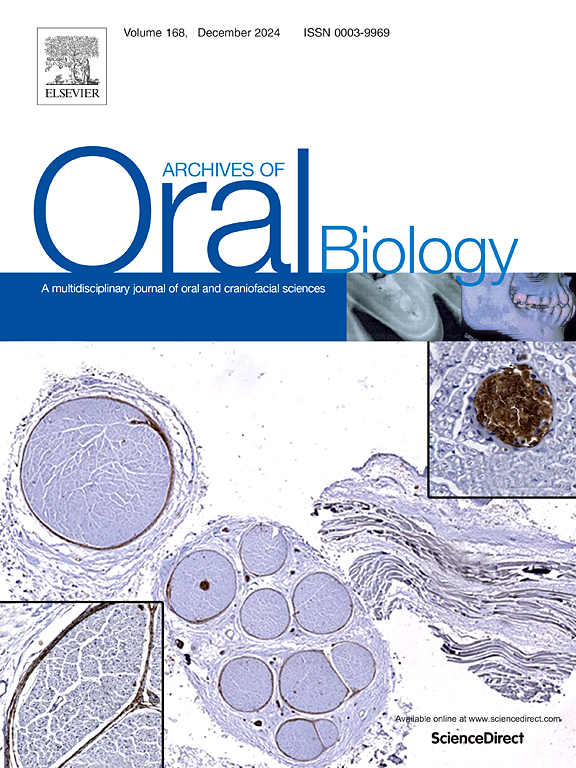短期机械劳损后牙周韧带肌成纤维细胞在大鼠和体外的存活:肌成纤维细胞是否会导致正畸复发?
IF 2.2
4区 医学
Q2 DENTISTRY, ORAL SURGERY & MEDICINE
引用次数: 0
摘要
目的:观察短期高实验性正畸力作用下大鼠PDL中肌成纤维细胞能否存活。目的:研究体外培养的人PDL成纤维细胞在去除化学或机械刺激后能否分化为肌成纤维细胞并存活。设计:选用6周龄雄性Wistar大鼠9只。使用橡皮筋将大鼠磨牙暴露在高但快速下降的实验正畸力下,并使用ASMA染色分析肌成纤维细胞的存在。在体外,将人牙周韧带(PDL)成纤维细胞暴露于转化生长因子β1 (tgf - β1)和/或机械应力下,并在这些刺激被取消后监测成肌细胞的形成和存活。结果:在体内暴露于正畸力强烈诱导肌成纤维细胞形成拉伸区PDL。此外,许多PDL肌成纤维细胞在暴露于这些短期高正畸力后6天仍然存在。人PDL成纤维细胞在tgf - β1暴露2天后分化为肌成纤维细胞,并在去除化学刺激(tgf - β1)或机械应变后至少存活2天。在体外条件下,tgf - β1和机械应变均可促进(肌)成纤维细胞的形成,并且在去除两种刺激后,这些细胞仍能存活3天。结论:机械应变去除后PDL肌成纤维细胞在体内和体外均能存活。这支持了一种假设,即肌成纤维细胞是在牙周韧带(PDL)的机械应变和化学信号的反应中形成的,在正畸牙齿移动后复发中起作用。本文章由计算机程序翻译,如有差异,请以英文原文为准。
Survival of periodontal ligament myofibroblasts after short-term mechanical strain in rats and in vitro: Could myofibroblasts contribute to orthodontic relapse?
Objectives
To investigate in vivo whether myofibroblasts formed in the PDL after exposure to short-term high experimental orthodontic forces in rats survive. To study in vitro whether human PDL fibroblasts can differentiate into myofibroblasts and survive when chemical or mechanical stimuli are removed.
Design
Nine 6-week-old male Wistar rats were used in this experiment. Rat molars were exposed to high but rapidly decreasing experimental orthodontic forces by applying a rubber band and analyzed for the presence of myofibroblasts using ASMA staining. In vitro, human periodontal ligament (PDL) fibroblasts were exposed to transforming growth factor β1 (TGFβ1) and/or mechanical stress and monitored for myofibroblast formation and survival after these stimuli were abrogated.
Results
In vivo exposure to orthodontic forces strongly induced myofibroblast formation in the stretched regions of the PDL. Furthermore, many PDL myofibroblasts remained present 6 days after exposure to these short-term high orthodontic forces. Human PDL fibroblasts were shown to differentiate into myofibroblasts after 2 days of TGFβ1 exposure and survive for at least 2 more days after removing chemical stimuli (TGFβ1) or mechanical strain. Under in vitro conditions, both TGFβ1 and mechanical strain for 3 days promoted (myo)fibroblast formation, and these cells persisted for 3 more days after the removal of both stimuli.
Conclusions
PDL myofibroblasts survive after the removal of mechanical strain in vivo and in vitro. This supports the hypothesis that myofibroblasts, which form in response to mechanical strain and chemical cues in the periodontal ligament (PDL), play a role in relapse following orthodontic tooth movement.
求助全文
通过发布文献求助,成功后即可免费获取论文全文。
去求助
来源期刊

Archives of oral biology
医学-牙科与口腔外科
CiteScore
5.10
自引率
3.30%
发文量
177
审稿时长
26 days
期刊介绍:
Archives of Oral Biology is an international journal which aims to publish papers of the highest scientific quality in the oral and craniofacial sciences. The journal is particularly interested in research which advances knowledge in the mechanisms of craniofacial development and disease, including:
Cell and molecular biology
Molecular genetics
Immunology
Pathogenesis
Cellular microbiology
Embryology
Syndromology
Forensic dentistry
 求助内容:
求助内容: 应助结果提醒方式:
应助结果提醒方式:


